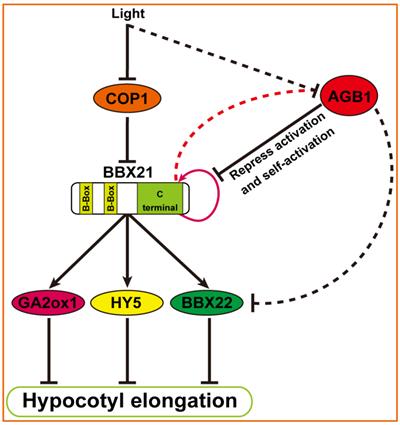The G-protein β subunit AGB1 promotes hypocotyl elongation through inhibiting transcription activation function of BBX21 in Arabidopsis
作 者:Dong-bei Xu,Shi-qing Gao,Ya-nan Ma, Xiao-ting Wang, Lu Feng,Lian-cheng Li,Zhao-shi Xu,Yao-feng Chen,Ming Chen,You-zhi Ma
影响因子: 8.827
刊物名称: Molecular Plant
出版年份:
卷: 期:9 August 页码:
doi:10.1016/j.molp.2017.08.004
文章摘要 :
Hypocotyl development in Arabidopsis thaliana is regulated by light and endogenous hormonal cues, making it a good model to study the interplay between light and endogenous growth regulators. BBX21, a B-box (BBX) like zinc-finger transcription factor, integrates light and ABA signaling to regulate hypocotyl elongation in Arabidopsis. Heterotrimeric G-proteins are pivotal regulators of plant development. The short hypocotyl phenotype of the G-protein β subunit (AGB1) mutant (agb1-2) has been previously identified, but the precise role of AGB1 in hypocotyl elongation remained enigmatic. Here, we show that AGB1 directly interacts with BBX21, and the short hypocotyl phenotype of agb1-2 is partially suppressed in agb1-2bbx21-1 double mutant. BBX21 is a downstream component of AGB1, and over-expression of BBX21 in the agb1-2 mutant background causes a more pronounced reduction in hypocotyl length, indicating that AGB1 plays an oppositional functional role in relation to BBX21 during hypocotyl development. Further, we demonstrated that the C-terminal region of BBX21 is important for both its intracellular localization and its transcriptional activation activity, which is inhibited by interaction with AGB1. ChIP assays confirmed that BBX21 specifically associates with its own promoter, and those of BBX22, HY5, and GA2ox1, and this interaction is not altered in agb1 mutants. These data suggest that the AGB1-BBX21 interaction only affects the transcriptional activation activity of BBX21, but has no effect on its ability to bind DNA. Taken together, our data demonstrate that AGB1 positively promotes hypocotyl elongation through the repression of BBX21 activity.
下载链接:www.cell.com/molecular-plant/abstract/S1674-2052(17)30234-4





